
South Brisbane Library is a heritage-listed former library at 472 Stanley Street, South Brisbane, City of Brisbane, Queensland, Australia. It was designed by Francis Drummond Greville Stanley and built from 1881 to 1902 by W Macfarlane. It is also known as South Brisbane School of Arts, South Brisbane Mechanics Institute, South Brisbane Technical College, and South Brisbane Post & Telegraph Office. It was added to the Queensland Heritage Register on 21 October 1992. It now houses the Griffith University Film School, which forms part of the Queensland College of Art.
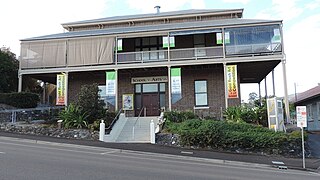
Gympie School of Arts is a heritage-listed school of arts at 39 Nash Street, Gympie, Gympie Region, Queensland, Australia. It was designed by architect Hugo William Du Rietz and was built from 1904 to 1905. It was added to the Queensland Heritage Register on 23 April 1999. It is now home to the Gympie Regional Gallery.

Maryborough Base Hospital is a heritage-listed hospital at Walker Street, Maryborough, Fraser Coast Region, Queensland, Australia. It was designed by Queensland Colonial Architect John James Clark and built from 1887 by Robert Taylor. It is also known as Maryborough General Hospital. It was added to the Queensland Heritage Register on 2 February 1998.

Maryborough School of Arts is a heritage-listed School of Arts building at 427 Kent Street, Maryborough, Fraser Coast Region, Queensland, Australia. It was designed by John Harry Grainger and built from 1887 to 1888 by Jacob & John Rooney. It is also known as Museum and Technical College and Recreation Club. It was added to the Queensland Heritage Register on 21 October 1992.

Bundaberg School of Arts is a heritage-listed former school of arts and now community centre at 184 Bourbong Street, Bundaberg Central, Bundaberg, Bundaberg Region, Queensland, Australia. It was designed by Anton Hettrich and built from 1888 to 1889. It was added to the Queensland Heritage Register on 21 October 1992.

Rockhampton School of Arts is a heritage-listed former school of arts at 230 Bolsover Street, Rockhampton City, Rockhampton, Rockhampton Region, Queensland, Australia. It was designed by William (Walter) Cherry built in 1894 by Walter Adam Lawson. It is also known as Rockhampton Regional Library and Rockhampton Municipal Theatre. It was added to the Queensland Heritage Register on 21 October 1992.

Townsville Customs House is a heritage-listed former customs house at Wickham Street, Townsville CBD, City of Townsville, Queensland, Australia. It was designed by George David Payne and built from 1900 to 1902 by Crawford & Cameron. It was added to the Queensland Heritage Register on 7 February 2005.

Tattersalls Hotel is a heritage-listed hotel at 87 Flinders Street, Townsville CBD, City of Townsville, Queensland, Australia. It is also known as Molly Malone's Irish Pub. It was added to the Queensland Heritage Register on 21 October 1992.

Bank of New South Wales Building is a former heritage-listed bank at 101–111 Flinders Street, Townsville CBD, City of Townsville, Queensland, Australia. It was built in 1887 by Denis Kelleher. It is also known as Australian Meat Industry Employees Union. It was added to the Queensland Heritage Register on 21 October 1992.

Queensland Building is a heritage-listed office building at 104–106 Flinders Street, Townsville CBD, City of Townsville, Queensland, Australia. It was designed by Mark Cooper Day and built from 1890 to c. 1971 by John Petrie & Son. It is also known as North Queensland Insurance Building. It was added to the Queensland Heritage Register on 21 October 1992.

Synod Hall is a heritage-listed Anglican church hall at 36 Cleveland Terrace, Townsville CBD, City of Townsville, Queensland, Australia. It was built from 1897 to 1898. It is also known as Jubilee Hall and Parish Room. It was added to the Queensland Heritage Register on 21 October 1992.

Townsville Magistrates Court is a heritage-listed former courthouse and now theatre at 81 Sturt Street, Townsville CBD, City of Townsville, Queensland, Australia. It was designed by Francis Drummond Greville Stanley and built from 1874 to 1876 by J & J Rooney. It is also known as Townsville Court House and Townsville Museum. It was added to the Queensland Heritage Register on 21 October 1992.

Drystone Wall is a heritage-listed drystone wall at 2–4 Cleveland Terrace, Townsville CBD, City of Townsville, Queensland, Australia. It was built in 1877. It is also known as Queensland Transport, Townsville Library and School of Arts/Licence Testing Centre, and Townsville Supreme Court. It was added to the Queensland Heritage Register on 7 February 2005.
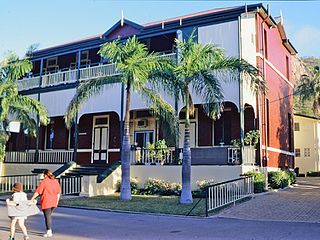
School House at Townsville Grammar School is a heritage-listed school building at Paxton Street, North Ward, City of Townsville, Queensland, Australia. It was designed by Tunbridge & Tunbridge and built from 1903 to 1904. It was added to the Queensland Heritage Register on 31 December 2002.

The Magnetic House is a heritage-listed office building at 143–149 Flinders Street East, Townsville, City of Townsville, Queensland, Australia. It was designed by C H E Blackmann & John Sulman and built from 1886 to 1888 by Dennis Kelleher. It was later known as Magnetic House. It was added to the Queensland Heritage Register on 21 August 1992.

Australian Joint Stock Bank Building is a heritage-listed bank at 173 Flinders Street, Townsville CBD, City of Townsville, Queensland, Australia. It was designed by Francis Drummond Greville Stanley and built from 1887 to 1888 by MacMahon & Cliffe. It is also known as Australian Bank of Commerce and The Bank Nite Club. It was added to the Queensland Heritage Register on 21 October 1992.

Atkinson & Powell Building is a heritage-listed former pharmacy and now general commercial premises at 181–183 Flinders Street, Townsville CBD, City of Townsville, Queensland, Australia. It was designed by Willoughby Powell and built in 1887. It is also known as Matchbox Theatre. It was added to the Queensland Heritage Register on 21 October 1992.
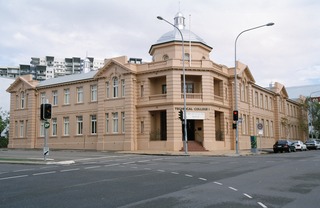
Block A of Townsville Technical College is a heritage-listed technical college building at 212–260 Stanley Street, Townsville CBD, City of Townsville, Queensland, Australia. It was designed by Department of Public Works (Queensland) and built from 1920 to 1921. It is also known as Townsville State High School and the City Campus of the Barrier Reef Institute of TAFE. It was added to the Queensland Heritage Register on 13 May 2004.
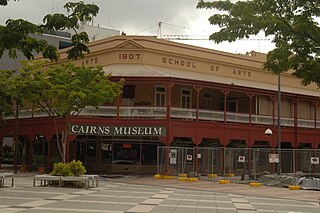
Cairns School of Arts is a heritage-listed former school of arts and now the Cairns Museum at 93–105 Lake Street, Cairns City, Cairns, Cairns Region, Queensland, Australia. It was designed by Tunbridge, Tunbridge & Lynch and built from 1907 to 1941 by Hanson & Sons. It was added to the Queensland Heritage Register on 21 October 1992.
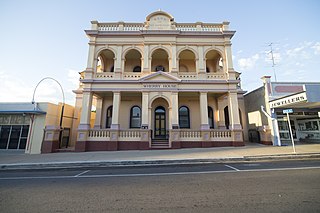
Bank of New South Wales is a heritage-listed former bank building at 34–36 Gill Street, Charters Towers City, Charters Towers, Charters Towers Region, Queensland, Australia. It was designed by Eyre & Munro and built in 1889 by Kelleher. It is also known as Wherry House. It was added to the Queensland Heritage Register on 9 November 2012.























